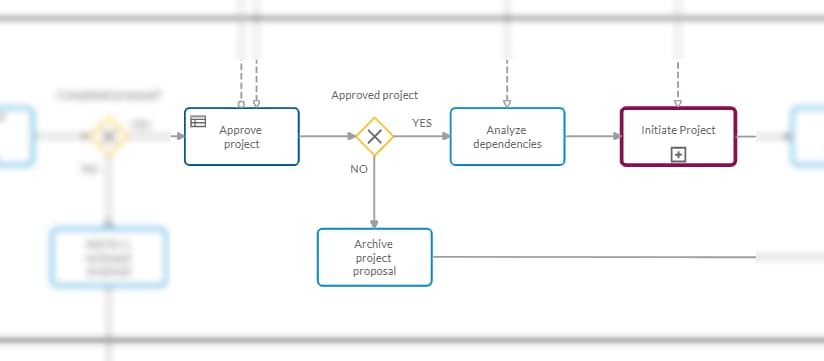How BPMN and DMN templates simplify IT Project Portfolio Management
Written by Alessandro Turco
10 June 2021 · 5 min read

Project Portfolio Management (PPM) is like a strategic roadmap for organizations. Unlike Project Management, which focuses on individual projects and short-term objectives, PPM looks at the broader picture. It aligns various projects with long-term strategic goals, ensuring resources are used wisely and each project contributes to the organization's overall success.
With proper Project Portfolio Management, companies can avoid numerous problems. For example, unbalanced project portfolios in terms of risk and strategic relevance, inefficient resource use, and missed deadlines. A well-implemented PPM practice helps bridge product gaps, optimize resources, minimize risks, and ensure organizational success.
In the following sections, I’ll explain how Cardanit, an intuitive BPMN and DMN editor, can help implement good Project Portfolio Management practices in IT companies. You’ll also learn how to use BPMN and DMN templates to analyze projects and ensure their alignment with business goals.
Finding a prompt to model business processes and decisions
Here at Cardanit we do our best to offer a Business Process Model and Notation (BPMN) and a Decision Model and Notation (DMN) editor that helps you focus more on process modeling and less on the modeling process. We appreciate the value of the standards and we are aware that they are complex.
I recently listened to a podcast featuring B. J. Fogg, the author of the book “Tiny Habits”. He explained one of the key ideas of his research: any action requires a good combination of three elements to happen and those are motivation, ability and a prompt. The more motivation you have, the less ability you need. Vice versa, if you have low motivation, you can do only things that are easy for you. But, in any case, without a prompt, a cue you cannot start moving.
I don’t know whether you love your job or not. Chances are that you do like process modeling if you are reading this blog. However, we designed Cardanit with the aim of lowering the ability threshold. We want to make BPMN and DMN accessible even to those people whose first thought in the morning is not whether a send task is more appropriate than an intermediate throwing message event, or how much a “U” table is clearer than a “F” one. So, I covered motivation and ability. Let’s talk about the prompt.
B. J. Fogg’s lesson reinforced one of our recent considerations: we need to improve the “prompt” part. Together with a renewed editor homepage we decided to partner with valuable consulting firms and to offer ready-to-use templates addressing common and challenging problems. We started from Project Portfolio Management tailor-made for the IT sector by QUIN, an Italian consulting firm we teamed up with.
Project Portfolio Management, an important process to handle the right resources
Project Portfolio Management is a process often left unmanaged, especially in growing and less structured businesses. This quickly results in shortage of resources (human, but also IT and other types), loss of synergies and increasing conflicts. QUIN observed this behavior in several companies and they report that the root causes are often:
- Missing filter for incoming projects
- Projects tend to run local optimization of resources without considering the global company-wide optimum. Enterprise architecture suffers the most from this.
- Project managers are sometimes unaware of possible synergies or conflicts among projects in terms of resources and activities.
- Top management can't focus on the big picture because there are so many details changing at a high pace.
QUIN relies on established methodologies to handle these situations. For example, ITIL and COBIT, as well as their own proprietary assessment protocols. The BPMN and DMN templates they designed for Cardanit is the generalized version of a real workflow modeled for an IT company of around 200 employees.
BPMN and DMN templates to successfully analyze projects

The BPMN part explains how to manage the project funnel. The main actor is the Project Management Office (PMO) that is responsible for the management of the portfolio. However, it's not the PMO that instantiates the process. A project can enter the funnel either via a Demand Manager or through the Enterprise Architecture department of the company. In both cases, the PMO carries on the assessment of the project collecting the required information from the stakeholders. A decision gateway determines the path of the project that can be dismissed if it does not align with the company strategy or does not guarantee a sufficient ROI.
After the approval, there are some coordination steps to be performed before the assignment of the PM and hence the project kick-off. The “Initiate Project” is a call activity in the template: this is your prompt! Here’s where the specificity of your company starts to count. Create a new diagram tab and map how you would handle this phase of the process. We have also a video to explain how to work with call activities.
QUIN also provided a DMN part for this template. The project approval decision is the central activity in the process. They suggest using DMN decision requirements graphs to decompose the final decision and to highlight the relevant components. Moreover, QUIN suggests a decision logic useful to rationally agree on the output. The final decision regarding the project approval (which is the one performed by the homonymous Business Rule Task in the BPMN model) has two inputs:
- the “Contribute to strategy” provided by the top management of the company,
- the “Priority assessment” which is the output of another decision.
As you can see in the “Logic” tab, a project is approved if the contribution to the strategy is high (regardless of the score in the priority assessment), or if the contribution is medium and the priority is high or medium. In all other cases the project is dismissed. The logic of the “Priority assessment” decision involves more inputs (Architectural alignment, ROI, Resource availability and Risk level), but it's not more complex. Both DMN tables are of type “U”, meaning that there is one and only one rule corresponding to each combination of input values.

Figure 1: The traditional way – sending process models back and forth
If you are a business analyst for an IT company, or you are a business consultant working on an IT case, you are familiar with these concepts. QUIN experience, but also our experience as a software house, tells that a growing company sooner or later has enough projects to require a proper project portfolio management. The template we offer is a good first step on the path to success. You can play with it and adapt it to your environment: what is a “low”, “medium” or “high” ROI for your company? Use the magic wand to transform the plain tasks into User Tasks. Then, you can assign them to the right people in your organization. Use another decision table to define the “Risk level” in a clear way (and remember to update the Decision Requirement Graph accordingly). Is this a good prompt to start modeling with Cardanit?
We believe that these BPMN and DMN templates can be helpful also for other industries. With minor changes, they can satisfy the needs of every company willing to switch from local optimization of scattered projects to a global alignment with company strategy and policies.
Contact us if you need assistance with the template in Cardanit. And you can also contact QUIN if you need their help in implementing the process.
Further reading
Interview with Francesco Falcolini: Overcoming the challenges in mapping modern IT processes
BPMN/DMN modeling for transforming IT business processes
Alessandro Turco has a PhD in Applied Math from the International School of Advanced Studies (SISSA) of Trieste and a Master in Management from the School of Management of Milan Polytechnic (MIP). He worked for ESTECO SpA for ten years, starting as a researcher for the Numerical Method Group and then moved to project manager of Cardanit.
Alessandro Turco has a PhD in Applied Math from the International School of Advanced Studies (SISSA) of Trieste and a Master in Management from the School of Management of Milan Polytechnic (MIP). He worked for ESTECO SpA for ten years, starting as a researcher for the Numerical Method Group and then moved to project manager of Cardanit.
People also ask
The templates in project portfolio management play a crucial role in resource allocation by offering visibility into resource utilization across projects. They allow managers to track availability, skillsets, and workload distribution to avoid overallocation or underutilization. Additionally, integrating decision modeling (DMN) can enhance the prioritization of projects, ensuring that resources are allocated to high-impact initiatives. By streamlining this process, the templates help balance short-term project demands with long-term strategic goals, ensuring efficient use of both human and financial resources.
The integration of BPMN (Business Process Model and Notation) and DMN (Decision Model and Notation) with Cardanit enhances traditional project portfolio management tools by providing a clearer, structured representation of workflows and decision-making processes. BPMN helps visualize and analyze complex IT processes, making it easier to identify inefficiencies or bottlenecks. DMN complements this by offering a standardized way to automate decision-making, ensuring that project choices align with established business rules. Together, these tools improve transparency, consistency, and efficiency in managing multiple IT projects, offering a more robust approach than traditional methods.
Adapting these templates outside of the IT sector can present significant challenges, primarily due to industry-specific workflows and requirements. For example, industries like healthcare or manufacturing often have more complex regulations, longer project timelines, or different resource constraints. These sectors may need modifications in how the templates approach prioritization, risk assessment, and resource allocation.
Learn how Cardanit can help you streamline and analyze business processes in the IT sector.
Streamlining IT processes with BPMN
Learn how Cardanit can help you streamline and analyze business processes in the IT sector.
Streamlining IT processes with BPMN
Learn how Cardanit can help you streamline and analyze business processes in the IT sector.
